Giving the Gift that Grows
Over the past few years I’ve been changing my gift-giving game. I used to give generic items that people might like but might not be useful to them. When receiving items like this I thought, “if I don’t like receiving gifts like this then why should I give them?” It’s a waste of money and the person is stuck trying to figure out what to do with it. I’ve changed my mindset to giving things that I know they need/want, are useful, something enjoyable, or money when nothing fits the above criteria. At any point during the year, if a person says they’d like something, I make a note of the need/want on my phone for future gift-giving occasions. One Christmas I gave jars of red and green M&Ms with a little cash hidden in the center, creating a 3-in-1 useful gift with the delayed experience of finding money. I’ve also thrown parties that the person will enjoy, but lately I’ve been giving plants to friends who I know will enjoy them.
If you’re at a loss for a gift, consider giving a plant. Plants are wonderful gift-giving investments as they are constantly morphing through the seasons in life, hibernation, and death, and we are privy to watch. When in bloom, they can attract visiting pollinators causing you to pause, observe, and enjoy the present moment, while they are busy sipping away at the sugary reward within. Live plants provide more value than any cut flower arrangement can, and if you give something that is not obvious at first, like the M&M jar, the mystery will reveal its secrets over time.

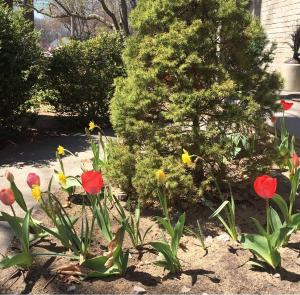
Tulips and daffodils were planted near her front door. Crocuses and daffodils were planted near the front lawn
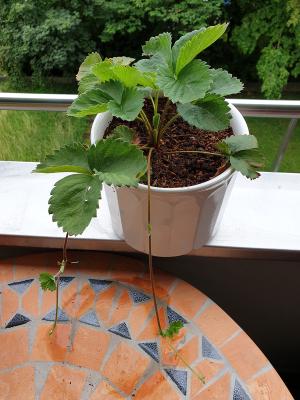
Strawberry plant with runners
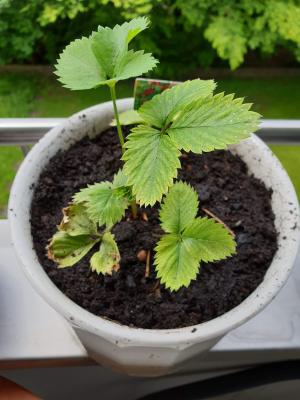
Sick strawberry plant after removing dead leaves and transplanting to a new pot
In October 2018, I gave what seemed like a bowl of rocks and dirt for a friend’s birthday. I told her, “place it outside for winter, keep it moist, and you’ll be rewarded in spring.” To her delight, in March she produced yellow and purple crocuses, in April came the daffodils, and in May tulips should have popped up—but they never did. This might of been a bad batch of tulip bulbs, or my excitement in overstuffing the pot. Either way, she loved it.
Inspiration for this surprise spring bulb planter came from an act in October 2017, when I took advantage of a half-off spring bulb sale and planted over 100 bulbs at my mother-in-law’s house. She forgot about them and the following spring was pleasantly surprised with a bounty of color in her front yard. Over time, the bulbs will multiply and provide even more color for her to enjoy.
If you don’t want to delay the gift’s suspense, you can always pot-up a variety of plants, creating a unique planter to tailor someone’s specific interests. In the summer of 2019, I gave a group of friends a hummingbird planter. The group was so generous allowing my husband and I to crash at their place for over a week, I decided to give them a special planter. The idea came from one of the researcher’s subjects of study, hummingbirds. He travels a lot and doesn’t have time to maintain a traditional feeder which requires cleaning and refilling every few days to prevent spoiling. I potted-up a large container with a few varieties of hummingbird favorites and told them to wait. It attracted multiple insect pollinators including bees, butterflies, and wasps and a month later, they spotted a hummingbird feeding from it!
This fall, a friend is expressing her desire to create a Balkongarten for next year and it just so happens that I have a strawberry plant with runners which I can give for her birthday in December.
If you decide to give a friend or family member plants, be sure to give them something low maintenance or at their skill level. Spring bulbs in a yard require no maintenance. The spring bulb planter required minimal watering, maybe once a month to every other month in winter. Something she could handle since she and her husband grow a forest of tomatoes, eggplants and peppers on their balcony every summer. Balkongarten friend is a beginner and is nervous that she’ll have a brown thumb, so I’m giving her easy-to-grow seeds and a difficult-to-kill plant. How do I know it’s difficult to kill? Well, I abused this particular strawberry plant. A lot of events occurred in 2018—the homemade potting mix that killed a bunch of plants; the balcony being demolished for the entire summer—that caused this one euro strawberry plant to be severely neglected in its original tiny pot. Come spring 2019, it was still alive, barely, so I finally planted it in a larger pot thinking it was probably a waste of soil. Turns out it recovered and by late summer started creating runners! No strawberries have been produced on this particular plant, which isn’t a surprise due to its abused past, so I can’t guarantee she’ll get strawberries in spring 2020 but I can guarantee that they’re tough to kill.
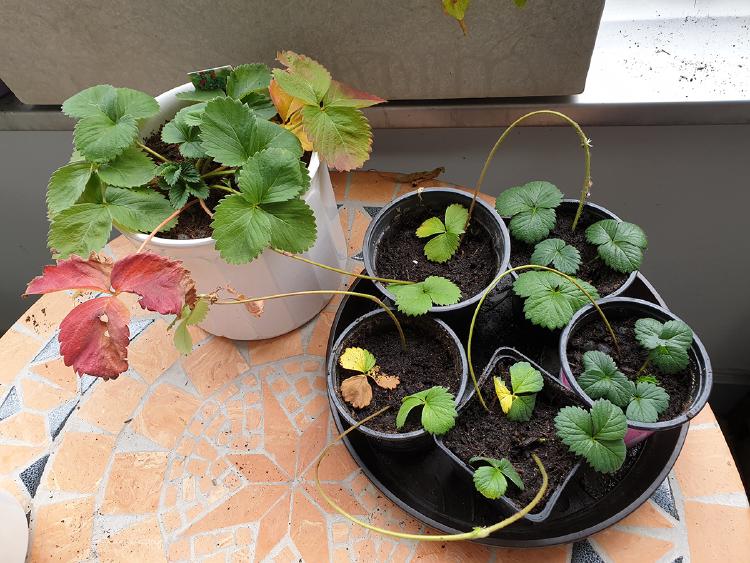
To root strawberry runners, all you need to do is fill up a pot with potting mix, push the plantlet into it, and wait a few weeks for the roots to develop before cutting the running stem from the mother
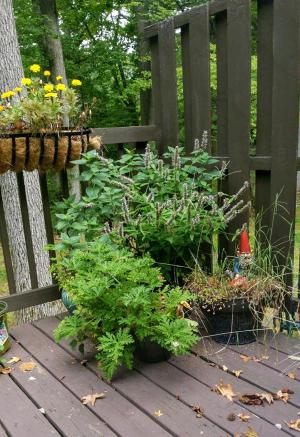
The hummingbird planter included a red Bee balm Monarda, a light blue Giant Hyssop Agastache foeniculum, a white Lantana Lantana camara, and a purple Salvia Salvia. In hindsight, I should have bought more mature Lantana and Salvia plants, as they were too small to compete and were engulfed by the Bee Balm and Giant Hyssop

Efeutute Epipremnum aureum. Small money plant propagated from cuttings Planted in an insert pot placed within a white decorative pot
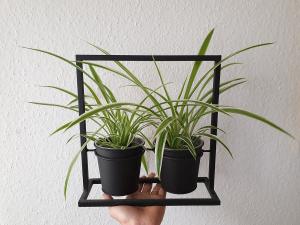
Gruenlilie Chlorophytum comosum. Small spider plants from spiderettes. Spiderettes are similar to strawberry plantlets created by runners from the mother plant.
The hummingbird planter requires a slightly higher skill level and one that I knew the group could handle. They already had planters of marigolds, hot peppers, and herbs on their deck, so I filled a large container with low maintenance, hummingbird-loving plants. All they had to do was water it, feed it every so often, and deadhead it so the flowers would keep coming back—the same maintenance they were already doing with their other containers. At the end of the year or next spring, they could also split the plants in half to create more containers and potentially attract more hummingbirds. Or, they could plant them out in the garden, so long as they don’t mind the Bee Balm and Giant Hyssop spreading. These are native to their region but are members of the mint family. If you’re familiar with mint family members you know they grow like weeds. So they either need space to grow or barriers to contain them, such as a berm—the strip of soil between a street and a sidewalk.
If you have a friend or family member expressing they’d like to grow something indoors, but are inexperienced or have a brown thumb, try Money Plant Epipremnum aureum (also commonly called pothos) or Spider Plant Chlorophytum comosum. These houseplants can handle neglect and recover well after neglected periods, especially the money plant. They are also great plants to learn propagation techniques. If giving a store-bought houseplant and you’re not short on time, I suggest repotting it into a slightly larger pot at least one or two weeks before giving it. Waiting, will allow you to watch and care for it during its recovery after transplanting, and when given, will have started actively growing roots and shoots providing a boost of confidence for the person. Just be sure it’s in a pot with drainage, whether it’s in a light insert pot or a decorative pot with holes. If you plant it directly in a decorative pot without drainage holes, you’re setting up your friend for failure.
Plants are wonderful gift-giving investments. Just be sure to give the person a plant they can handle and one that fits their personality in order for it to be a successful gift-giving experience.
- Filed to:
- Gifts
- Balkongarten


